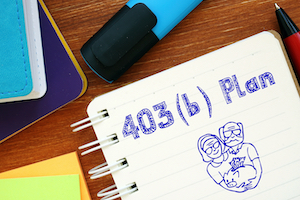While participation rates in 401(k) plans dropped in 2022, participation rates increased in 403(b) plans in the same time frame to a record high, according to the Plan Sponsor Council of America’s (PSCA) 2023 403(b) survey.
 PSCA is part of the American Retirement Association.
PSCA is part of the American Retirement Association.
The survey, sponsored by HUB International and Principal Financial Group, gathered information from 250 nonprofit organizations that sponsor 403(b) plans for employees and revealed that 80% of eligible employees contributed to their plans in 2022.
Additionally, nonprofits contributed an average of 30% more to employee accounts—an average of $6,322 per participant.
“While contribution rates slipped among the private sector in 2022, nonprofit employees and employers maintained or increased plan contributions,” said Hattie Greenan director of research and communications at PSCA. “Additionally, organizations added plan design features aimed at increasing participation and savings rates, including automatic enrollment.”
Automatic Enrollment
Automatically enrolling employees into a retirement plan has been commonplace in 401(k) plans for a while now and may finally be taking hold in 403(b) plans after years of very slow growth.
Nearly one-third of nonprofits automatically enroll new hires into the plan, up from one quarter the year before, PSCA reports.
Not only are organizations increasingly using automatic enrollment, they are also using it with higher default rates and automatically increasing those default rates over time, the findings further show.
Availability: The use of automatic enrollment jumped by nearly 20% in 2022 and is now used by 31.4% of plans, up from 26.5% the year before.
Defaults: More than one third of plans with automatic enrollment use a default deferral rate greater than three percent (36.1%), up from 26.9% in 2021.
Escalation: Two-thirds of plans now automatically escalate the default deferral percentage over time, up from 57% in 2021.
“It was never very clear why the use of automatic enrollment in 403(b) plans lagged significantly behind their 401(k) counterparts,” Greenan further observed. “Seeing it begin to take hold in the nonprofit space, especially as it is largely seen as a best practice in retirement plan administration, bodes well for the increased retirement security for those who dedicate their time to mission-focused organizations, often for less pay than in the corporate world.”
Other Plan Design and Administration Features
PSCA’s survey also revealed increases in immediate eligibility to receive contributions, an increase in Roth availability, and an increase in the use of Investment Policy Statements (IPS).
Eligibility: Nearly half of plans allow participants to receive matching contributions immediately upon hire (47.8%), up from 36.3% in 2021.
Roth: Roth availability continues to climb with two-thirds now making it available as an option, up from 58.8% in 2021.
Investment Policy Statements: There has been a slow, steady increase in plans adopting an IPS with 63.3% of organizations now having one in place (up by 25% in a decade).
PSCA’s annual 403(b) Plan Survey is the only independent 403(b) research report that delivers actionable data on trends among plan sponsors in the nonprofit sector.
For more survey results, visit https://www.psca.org/research/403b/2023AR. Media copies can be requested at [email protected].

